Here is some more detail from your teachers about the topics they will be presenting at the weekend
Gianfranco Pace
1. Qi Gong of the intention: ‘The archer’
2. The water Qi Gong/Nei Gong
3. Qi Gong of the tendons (first part)
4. Tui Shou (basic principles)
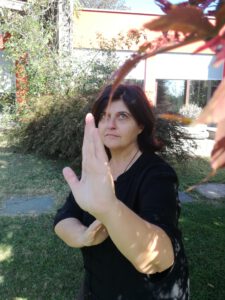
Chiara Vendettuoli
Swimming Dragon
The living system is an ‘open’ system that constantly receives and emits energy in its relationship with the environment. The accurate regulation of physiological processes occurs by means of a complex communication system, through orderly fluctuations of the electromagnetic field.
The Swimming Dragon is a method consisting of a series of connected movements, performed paying special attention to the integration and harmonisation of the systems and structure we are made of.
Through coherence and regulation we can achieve a harmonious balance (physical, mental and emotional) between body and mind.
Biospirals Meditation
The Biospirali method is Chi Kung using images and breathing, movements inspired by the path representing the intelligence of the cosmos: the spiral.
During this session we will practise preparatory exercises for the Biospirali and meditation.
Through breathing and some static postures we will enhance the flow of life, bringing mind and body back to a condition of balance.
Peng, Lu, Ji and An
Which came first: the chicken or the egg?
John Bolwell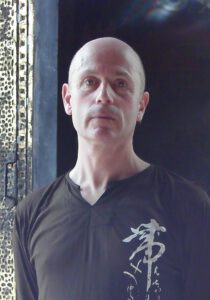
1. Flying Crane Qigong
A stationary 12 movement Qigong sequence mimicking many characteristics of the crane.
2. Ba Gua Spiralling Palms
The foundation for much of the flowing and coiling full-bodied movement in Ba Gua.
3. Snake in the Lotus Palm
Extracts from a longer Snake Qigong sequence. Particularly develops articulation and expression within the hands and fingers along with a sinuous body.
4. Heaven & Earth Balancing Qigong
A 6 movement Qigong sequence which enhances coordination through simple but challenging patterns of movement.
Paul Silfverstrale 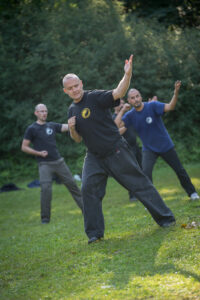
1. Position is power. Period.
2. Range…are you within it
3. Square, triangle and circle – Secrets of the Universe
4. Applying Form or Forming Applications?
Sam Masich
5 Words of Self-Composure
We will learn the 5 Words and explore how they can be used in other areas such as qigong, taiji forms and push-hands. This workshop will help you go deeper into all areas of the internal arts
Sensing Hands
Rest, support, adhere and follow. Introduction to push-hands and the 8 disk frame.
This session will introduce the basic push-hands understanding of the taiji- Classics around this concept.
Taiji Sabre
A basic Taiji Dao form with a partner that will get us to know the weapon and its energies.
Chen Yanlin ‘21 Movements, Strengthen Body & Mobilize Qi’
This 21 movements routine is considered valuable for loosening the sinews (jīn) and opening up the meridians (jīngluò). At advanced levels of practice, the gestures of this section aid the development of martial energies (jiéjìn) and ‘cold energy’ (lěngjìn).
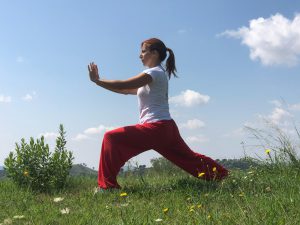 Margherita Padalino
Margherita Padalino
1. The importance of alternation in Taijiquan movement.
2. Basic exercises to train elastic force.
3. To let go (Fang Song): an exercise to train this important fundamental concept.
4. Basic exercises for discovering the center. Internal movement starts from the centre so it’s fundamental to have a clear appreciation of it.
Lucia Ring-Watkins 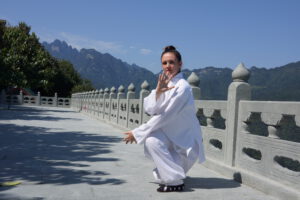
Posture & Power
A look at the basic Tai Chi stance and moulding the body to conduct internal power through standing stake. This is the main way Tai Chi powers are cultivated in the Wudang Pai style.
Wudang Footwork
How to shift the weight and maintain the skills built through standing when moving. Here we train the fundamentals of Wudang footwork.
Moving From the Centre
Basic skills to isolate and develop waist movement, which allows us to move using the whole power of the body. Later on down the line, this becomes moving using Dantian.
Joint by Joint Movement
This is the secret of the serpentine movements in Tai Chi, which is embedded at an early stage in Wudang Pai training. Movements from all four session will be linked together to make an opening sequence that features in many Wudang forms.
Javier Arnanz
1. Xingyiquan to create distortions in Taijiquan 1
During this session we will experiment with how some principles of the Xingyi and some of the basic fists and apply them in our Taichi practice.
2. Xingyiquan to create distortions in Taijiquan 2
In the same way an amplifier can create interesting distortions for the guitar, Xingyiquan can be used to create distortions in our Taiji practice. We will experiment with some Xingyi principles and introduce some basic fists and see how we can apply them in our Taichi practice.
3. San shou Chui. Tai Chi Three hand thumping
This two persons Taiji linking fist gives Taichi practitioner the opportunity to study the punch in a simple and fun exercise. This is a perfect complement and completes push hands training.
4. San Shou Pao. Xing Yi Three hand cannons
This two persons Xingyi drill introduces the practitioner to fighting training. You will start to see the relationship Xing Yi has with Tai Chi.
5. Whip hands qigong and fajin practice
A qigong set that is perfect for paractising fajin
Dee Swift
Helmut Oberlack 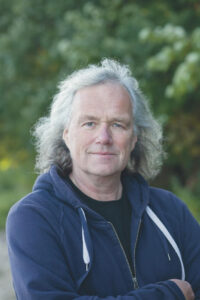
Shibashi Set 3
We do the Set 3 of the Shibashi System (Taiji Qigong). Set 3 contains also 18 different Movements, like the other sets. The movements are fairly easy to learn if you have previous experience in Qigong or Taijiquan, not necessarily in Shibashi. Set 3 has – in my humble opinion – a focus on the back, which is moved in a variety of ways.
Jin Jing Qigong
Jin Jing Qigong, sometimes calls “Shaking Qigong“, is a simple and effective method to release tension in the entire body. We put ourself in a comfortable shaking motion and then we go through the body parts one by one and observe how they slowly but surely relax more and more. Not recommended for people who are easily dizzy.
Pillars (or columns) of Qigong: Regulation of Breathing
Qigong is supported by three pillars: The regulation of body, breathing and mind. In this workshop we will look at the regulation of breathing (Tiaoxi). We will play around with our breathing and observe what influence the breath has on our practice and how we can come to a harmonious way of breathing.
Columns (or pillars) of Qigong: Regulation of the Mind
Qigong is based on three pillars: The regulation of body, breath and mind. In this workshop we will look at the regulation of the mind (Tiaoshen). We will play around with our attention and observe what influence the mind has on our practice and how we can come to a calm mind.
James Carss 
- Introduction to Han style Yiquan zhang zhuang concepts
- Pi Chuan element of xingyiquan
- Introduction to liuhebafa part 1
- Introduction to liuhebafa part 2
- Health Exercise of the Han Yiquan System
Copyright 2025 Tai Chi Caledonia | Privacy Policy

